Millions of reviews.
Nothing but the best.

Berlin is an edgy city, from its fashion to its architecture to its charged political history. The Berlin Wall is a sobering reminder of the hyper-charged postwar atmosphere, and yet the graffiti art that now covers its remnants has become symbolic of social progress. Check out the Weltzeituhr (world time) Clock, topped by a model of the solar system, then turn back...Berlin is an edgy city, from its fashion to its architecture to its charged political history. The Berlin Wall is a sobering reminder of the hyper-charged postwar atmosphere, and yet the graffiti art that now covers its remnants has become symbolic of social progress. Check out the Weltzeituhr (world time) Clock, topped by a model of the solar system, then turn back time by dining at the historic Zur Letzten Instanz, a 16th century restaurant that was frequented by Napoleon and Beethoven.
The Brandenburger Tor is a monumental gate built in the eighteenth century as a symbol of peace. During the Cold War, when the gate was located right near the border between East and West Berlin, it became a symbol of a divided city.
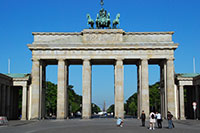
Brandenburg Gate
Since the fall of the Berlin Wall, the Brandenburg Gate has become the symbol of a reunified Berlin. The desolate area that Pariser Platz was during the Cold War, is now completely redeveloped and has regained much of its nineteenth-century grandeur.
Brandenburg Gate
The Brandenburg Gate is situated at the end of Unter den Linden, a grand boulevard in Berlin. It was originally part of a wall surrounding Berlin and was the main entrance to the city. It is the only gate that remains of this former city wall.
The monumental gate was designed by Carl Gotthard and commissioned by emperor Wilhelm II. The design of the gate, 65.5 meter wide and 28 meter tall was based on the Propylaea, the gateway to the Acropolis in Athens. It was constructed between 1778 and 1791 and replaced an older city gate. The decorations, including bas-relief scenes depicting Greek mythology took another four years to complete.
Quadriga
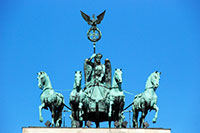
The Quadriga
The quadriga of victory crowning the gate was built in 1793 by Johann Gottfried Schadow. The bronze quadriga is driven by the goddess of peace; originally the gate was a symbol of peace.
In 1806, during Berlin's occupation by France, Napoleon ordered the quadriga to be taken to Paris. After the Battle of Waterloo, the quadriga was triumphantly taken back to Berlin, and it was turned into a symbol of victory. At the same time the square near the gate was renamed Pariser Platz and the statue on the quadriga was now called Victoria, after the Roman goddess of Victory.
After WWII
The gate, which by that time had become a symbol of Prussian militarism, was badly damaged during World War II. After the war and the division of Berlin, the Brandenburg Gate was right at the border between East and West Berlin, just inside the Russian sector.
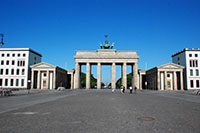
Pariser Platz
In 1958 the gate was restored by East Berlin, while West Berlin funded the reconstruction of the quadriga.
Berlin Wall
After the construction of the Berlin Wall in 1961 which was built right near the Brandenburg Gate, the Pariser Platz, on the East-Berlin side, became completely desolate. The gate symbolized Germany's division. With the fall of the wall in 1989, people flocked to the reopened Brandenburg Gate to celebrate.
The monument was renovated again in 2001; it opened as good as new on October 3, 2002.
Once the busiest crossing in Europe, the Potsdamer Platz was completely destroyed after the war. In 1998 the new Potsdamer Platz, full of modern buildings, officially opened.
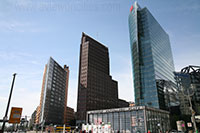
Potsdamer Platz
In the 1920s and 30s, the Potsdamer platz was the busiest and one of the liveliest squares in Europe. It was a major public transport hub and a popular entertainment district; the area contained numerous bars, cafés and cinemas.
This all came to an abrupt end in 1943 when the Potsdamer platz was left to ruins by allied bombing. After the second world war, the square located between the American, British and Russian sectors, became a no-man's land.
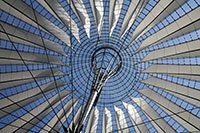
Tent-like roof of the Sony Center
It was completely flattened with the construction of the Berlin Wall in 1961 when the demolished buildings were pulled down. Redevelopment
After the fall of the Berlin Wall it was decided to rebuild the whole area, 480.000 square meter large. Construction started in 1994 and for many years Potsdamer Platz became the largest construction site in Europe. The square, together with several adjacent blocks were redeveloped
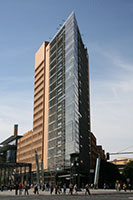
Debis Building B1
under the supervision of the architects Wilmer and Sattler.
The project included the construction of several landmark towers, a shopping arcade, an entertainment center and residential buildings.
The first building completed was the Debis tower, designed by Renzo Piano. Other eyecatchers are the Sony Center, a complex designed by Helmut Jahn which includes an Imax theater and an office tower. Its neighbor, the brown-brick Kohlhof building featured an observation deck at a height of 93m. The square today
The large new underground station, shopping arcade and entertainment center have brought new life to thePotsdamer Platz.
It still is more of a tourist attraction than a 'natural' square, but with the construction of more residential buildings in the neighborhood, the area has started to grow back to its former status: one of the liveliest squares in the country.
One of the largest zoological gardens in the world, Berlin's Zoologischer Garten has been thrilling visitors since it opened more than 150 years ago.
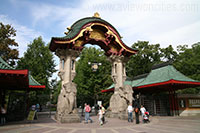
Elephant Entrance
First opened to the public in 1844, the Berlin Zoo was built upon a gift bestowed to the city by King Friedrich Wilhelm IV. The king provided animals from his menagerie to fill the cages and open habitats at the zoo, which was designed by Peter Lenne.
The idea for the zoo was the brainchild of Alexander von Humboldt and German-born African explorer and zoologist Heinrich Lichtenstein. It occupies the southwest portion of the Tiergarten, a large public park in the center of Berlin.
The zoo's population increased rapidly and literally thousands of animals had taken up residence there by the early to mid 1900s and the zoo was a popular attraction for those visiting the city, but after the destruction caused by the
war, less than 100 animals remained.
The Zoo Today
These days, as you enter the Zoologischer Garten through its Elephant or Lion Gates, you'll be treated to more than 15,000 animals representing about 1,400 species. Cages are rare. Most animals roam free in re-creations of their natural habitats.
Pandas and more
The pandas are the most popular residents of the Berlin Zoo,
attracting an amazing amount of attention from local media whenever they hit a landmark birthday or other occasion.
The Birdhouse is one of the most modern in Europe, boasting more than 500 species of birds, many of them quite rare.
The polar bears were also very popular when Knut - a polar bear cub rejected by its mother - was fed by one of the zookeepers.
Among the other well known species in the zoo are wolves, gorillas, elephants, seals, zebras, rhinoceros, lions, orangutans, giraffidae and okapis.
There's also an excellent aquarium adjacent to the zoo (you can buy a combo ticket) where you'll find not only fish but also insects, amphibians, and reptiles.
Kids love the Children's Zoo, where they can pet the animals, as well as the onsite playground, providing lots of room to run around after a long day of sightseeing.
Entrances
The zoo has two entrances, one is situated at the Hardenbergerplatz and is known as the Lion Gate since it is flanked by two small buildings with statues of resting lions. The other entrance, at the Budapester Strasse, is flanked by statues of elephants, appropriately known as the Elephant Gate.
The Berliner Fernsehturm is a television tower which rises to a height of more than 360 meters from its futuristic looking base at the southwest side of Alexanderplatz. The tower is the tallest structure in Berlin and can be seen from almost anywhere in the city. An iconic tower
The idea for the tower was launched in 1958, when the government of East Germany wanted to erect an iconic office tower at Alexanderplatz. In response, German architects Jörg Streitparth and Hermann Henselmann - a socialist architect known for his towers at the Karl Marx-Allee - proposed the construction of a television tower which was to be known as the 'Tower of Signals'. 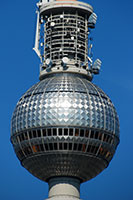
The sphere
Construction
The idea was unrealized until the end of the 1960s when it was relaunched. A team of East German architects designed the 368 meter (over 1200ft) tall concrete tower which was built with the help of Swedish engineers.
The structure consist of a large pavilion covered with white painted roofs enclosing the actual tower, a cylindrical concrete shaft topped by a steel-clad sphere and a large antenna.
When it opened in 1969 the tower was the pride of the DDR and communist propaganda films were shown here to promote the quality of life in East Berlin. Even today the tower is one of Berlin's most important landmarks, and in 1993 it was even officially designated as such.
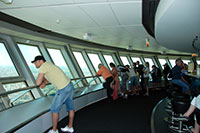
Viewing Platform
Viewing platform
Elevators at the base of the tower bring visitors to the large sphere, where a viewing platform allows for a 360 degree view of Berlin from a height of about 203 meters. Depending on the weather visibility can reach up to 40 km (25 miles). Just above the platform, at a height of 207 meter, is the Telecafé, a revolving restaurant.
One of the masterpieces of the area known as Museum Island, the Altes Museum (Old Museum) was the first dedicated museum building in Berlin. The building and statues
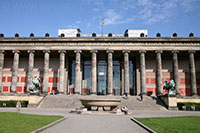
Altes Museum
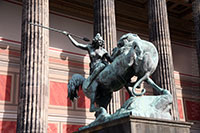
Statue at the entrance
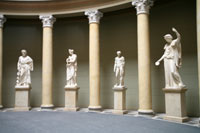
Rotunda
In the 17th century, princess Louise, daughter of Friedrich Wilhelm - also known as The Great Elector - built a beautiful pleasure garden on the tip of an island on the River Spree. Many years later, when one of his descendants ruled over Prussia, the need arose for a museum to house many of Germany's treasures, which had recently been recovered from France.
Thus, in the 1820s, Berlin's great architect Karl Friedrich Schinkel devised a plan for a new museum bordering the garden. Built between 1825 and 1830, the Altes Museum was the first in the city, fashioned in the Greek style. It was situated across the garden from the King's Palace, which was demolished World War II.
Eighteen Ionic columns grace the front of this grand museum. The rectangular shaped building encloses two generous courtyards and a two-story centrally-located rotunda, based on the design on the Pantheon in Rome. The interior of the rotunda contains sculptures of gods of antiquity in the recesses of its walls. Two statues flank the wide outdoor steps. Entitled Amazon and Lion Fighter, they were designed by August Kiss and Albert Wolff.
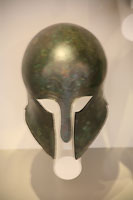
Greek Helmet
For more than a century, the Altes Museum was enjoyed by locals and visitors alike. However, as is true for much of Berlin, the museum did not survive World War II. Just prior to the end of the war, a tank truck exploded in front of the museum, destroying it completely.
The Museum Collection
After the war, the Altes Museum was the first of the group museums on Museum Island to be renovated and it reopened in 1966. Today, it houses the Antikensammlung (Museum of Antiquities) on its main floor. The permanent collection here includes a vast variety of ancient Greek and Roman decorative art including vases and statues. The Alte Nationalgalerie (Old National Gallery) is one of a group of museums at Berlin’s centrally located Museum Island. The museum boasts a fine collection of 19th century artwork, mainly paintings and sculptures from the German romantic period. Building the Gallery
Plans for the
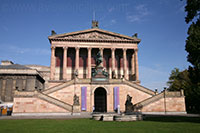
Alte National
galerie
Alte Nationalgalerie can be traced back to a drawing by king Frederick Wilhelm IV dated 1841. However, the credit for the design of this building, one of five on Museum Island, goes to architect Friedrich August Stüler who imagined a temple-like structure built on a pedestal of stone.
Work on the gallery began in 1866 but, unfortunately, Stüler died later that year. The management of the site reverted to Johann Heinrich Strack, who oversaw the project until its completion 10 years later, in 1876.
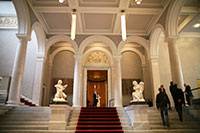
Main Hall
The most noticeable aspect of the museum is the massive steps outside the neo-Classical-style building. Though these were not included in Wilhelm's sketch, Stüler thought them appropriate for a building of such stature. There's also a marvelous sweeping staircase inside.
The Alte Nationalgalerie was largely destroyed during World War II. Many of the paintings and other works of art were
forever gone and some were moved to Russia. The Nazis also sold or destroyed paintings that they believed to be "degenerate", greatly reducing the museum's permanent collection.
Despite the massive amount of destruction, the museum was partially re-opened by 1949. However, Germany was soon to be divided and with the political division of Germany came the division of the collection at the Old National Gallery. Eventually, after the wall fell, the collection was reunited. Complete restoration of the museum
was completed in 2001 and the museum opened to the public once again.
About the Collection
Alte Nationalgalerie is most well-known for its fine collection of 19th century paintings. It's also home to the world's largest collection of works by the city's native son, Adolph von Menzel (1815-1905). The museum, the first on the island to be completely restored, also owns an impressive collection of 19th century sculpture.
The Soviet War Memorial in Treptower Park is the largest of several memorials that were built in Berlin to honor the Red Army soldiers who were killed in the Second World War.
The Great Patriotic War
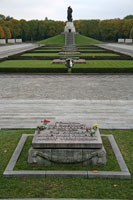
Soviet War Memorial
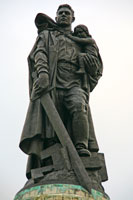
The Big Soldier
During the Second World War - known in Russia as 'The Great Patriotic War' - the Soviet Union suffered the largest losses of all nations involved, with more than twenty-five million of its people killed. During the battle of Berlin alone, which was fought between April 16 and May 2, 1945, 22,000 Soviet soldiers lost their lives.
To honor these soldiers and to celebrate the Red Army's victory over Germany the Soviet military ordered the construction of several memorials. The largest of these was built between 1946 and 1949 in Treptower Park, in southeast Berlin, where more than 7,000 Red Army soldiers were buried.
Construction
A competition organized to design the memorial received thirty-three submissions. An entry by a collaborative group consisting of an architect, an engineer, a sculptor and a painter was selected. A site of about ten hectares (25 acres) in the former borough of Treptow was chosen as the location for the memorial.
The bombastic memorial was built under the guidance of the Soviet Army with the help of almost 1,200 German workers. The memorial was officially dedicated on May 8, 1949 (the fourth anniversary of the surrender of the German army), by the Soviet commander in Berlin, Major General Alexander Kotikov.
The Memorial
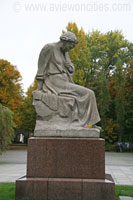
Mother Homeland
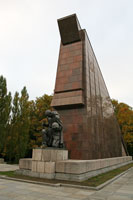
Marble wall
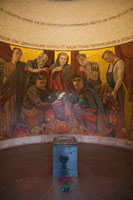
The crypt
The memorial was built in typical Stalinist style, with lots of symbolism and patriotic glorification. What the memorial lacks in artistic quality is compensated by sheer monumentalism.
Mother Homeland
Stone arches on two avenues - Pushkinallee and Am Treptower Park - mark the north and south entrance of the memorial site. They lead to an allegorical granite statue of Mother Homeland grieving for her dead children. Mother Homeland personifies the Soviet Union; before 1917 she was known as Mother Russia.
Esplanade
From here an esplanade lined with weeping birches creates a vista towards the centerpiece of the memorial: a colossal bronze statue of a Soviet soldier, the so-called 'Big Soldier'. The view is framed by two massive triangular-shaped walls guarded by statues of kneeling soldiers. The walls, engraved with hammer and sickle, symbolize lowered flags. They are made of red marble that is thought to come from the ruins of the New Reich Chancellery. From the end of the esplanade visitors have a view over the sunken cemetery.
Cemetery
The cemetery is decorated with two rows of limestone sarcophagi, sixteen in total. They represent the former republics of the USSR and are decorated with reliefs that depict scenes from the war. Quotes from Stalin are inscribed on the sarcophagi in German and Russian.
Big Soldier
The memorial culminates in a massive heroic monument known as the 'Big Soldier'. It shows a Soviet soldier holding a rescued child, a symbol of liberation. In his right hand he holds a sword that rests on a broken swastika. The bronze monument has a height of more than eleven meters (36 ft) and weighs about seventy tons. It was created by Yevgeny Vuchetich and cast in 1949 in Leningrad before it was transported in six pieces to Berlin.
|
 |

Munich exudes Bavarian charm. Beer fanatics should head immediately to the Hofbräuhaus, a hops heaven that’s been churning out the good stuff since 1589. The drinking is downright legendary during Oktoberfest, a celebration of local beers and German specialty foods. Emulate world-class athletes at the Olympiapark, where skating on the Olympic ice rink will make you...Munich exudes Bavarian charm. Beer fanatics should head immediately to the Hofbräuhaus, a hops heaven that’s been churning out the good stuff since 1589. The drinking is downright legendary during Oktoberfest, a celebration of local beers and German specialty foods. Emulate world-class athletes at the Olympiapark, where skating on the Olympic ice rink will make you feel like a champion. The promenade of Marienplatz is perfect for people watching and gawking at the Glockenspiele of City Hall.
Munich - Old Town

The Karlstor entrance to Munich's "Old-Town"
Getting Around
Tourist Munich is relatively compact and easy to walk in good weather. Alternatively, Munich’s extensive subway (U-Bahn) and light rail (S-Bahn) network make it easy to navigate the city. You can purchase relatively economical one or two-day passes for unlimited transportation around the city. Be sure to validate your ticket at one of the blue boxes before using the ticket.
Another alternative for seeing the city is the “Hop-On Hop Off” bus offered by the Gray Line that includes a tour guide (it’s usually the bus driver). The Grand Tour takes in all of the town's major sights and an Express Tour (less expensive) is focused on attractions in the city center. Lower fees are offered for children under 14. As indicated by the name, you can hop-off to see an attraction of interest and catch the next bus to continue your tour. Buses depart from the Bahnhofplatz on the east side of the central train station (Hauptbanhof). Look for the easy to spot line of double-decker buses.
We show the location of the attractions we recommend visiting in Munich on a detailed street map of provided by Google. Clicking the map symbol  , when it appears after the name of an attraction, will open our Munich Street Map to that location. The maps are at their most informative when you view them at large scale (magnified) and use the hybrid button, which shows street names on top of a satellite image of the area. , when it appears after the name of an attraction, will open our Munich Street Map to that location. The maps are at their most informative when you view them at large scale (magnified) and use the hybrid button, which shows street names on top of a satellite image of the area.
By the way, the best way to get into the city from the Munich Flughaven (Airport)  is to take the S-Bahn to the Hauptbanhof (Central Train Station) in the heart of the city. You can catch the train for the forty-minute ride into the city at the lower level of the main terminal. Buy your tickets from the automated ticket machines or from the travel desk, whose attendants are very helpful. The cost is extremely reasonable or you can get an all-day pass (single tageskarte) for slightly more. Taxis are € 80- 100, but may be a good deal if you are traveling with others or have lots of luggage. If you have a large group of travelers it will be more economical to arrange a van for your transportation into town. is to take the S-Bahn to the Hauptbanhof (Central Train Station) in the heart of the city. You can catch the train for the forty-minute ride into the city at the lower level of the main terminal. Buy your tickets from the automated ticket machines or from the travel desk, whose attendants are very helpful. The cost is extremely reasonable or you can get an all-day pass (single tageskarte) for slightly more. Taxis are € 80- 100, but may be a good deal if you are traveling with others or have lots of luggage. If you have a large group of travelers it will be more economical to arrange a van for your transportation into town.
While in Munich, you might be interested in a long day trip to Neuschwanstein Castle or other famous towns along the Romantic Road. Click here for our Guide to the Romantic Road.
|
|
|

Along the Kaufingerstraße

The Burgersaalkirche

Interior of St. Michael's Church in Munich

The bronze Boar, outside the Hunting and Fishing Museum.

Frontal view of the twin towers at the Frauen-kirche.

The Tomb of Louis IV, Holy Roman Emperor, in the Frauen-Kirche
|
Munich’s name is derived from a band of monks who settled the area around thirteen-hundred years ago. The settlement (“Zu den Munchen") officially became a town in the 12th century and was ruled by the Wittelsbach family (electors, dukes and eventually kings) until 1918, a period of nearly 800 years. Be sure to tour their palace, the Residenz, which we describe below. Throughout its history, Munich was often at the forefront of German politics, although its role as the birthplace of the 3rd Reich and the rise of the Nazi movement is not one that is celebrated.
Oktoberfest is Munich's world-famous beer-drinking festival. The fun runs for several weeks in late September and early October. The celebration is held at Theresienwiesen  (southwest of the Hauptbanhof) underneath tents capable of accommodating thousands of revelers. (southwest of the Hauptbanhof) underneath tents capable of accommodating thousands of revelers.
Facts you should know about Oktoberfest -
Oktoberfest starts in mid-September and usually ends in early October. Oktoberfest is now held earlier in the year than the original festival to take advantage of the weather. However, it can be cool and rainy in Munich in late September/early October. so be sure to bring rain gear to keep dry on your way to and from the festival.
Oktoberfest celebrated its 200th anniversary in 2010 with its 176th Oktoberfest, as the festival was not held every year since the founding of the event. The Weisn started in 1810 to celebrate the marriage of Prince Ludwig who became King Ludwig I (not the castle builder). Oktoberfest is a popular event and you will encounter huge, friendly crowds at the fairgrounds and around the city. Hotels are hard to find in Munich during this period, unless you have reserved far in advance.
Entrance to the fairgrounds is free, but if you want a good seat, be sure to arrive early. Many head to the Theresienwiesen (called die Wiesen) before the thirty-two "tents" (think beer pavilions) open, in order to ensure the best seats. Others reserve space in advance at their favorite tent.
Beer at Oktoberfest is sold by the Maß, a one-liter tankard. While entrance to the event is free, a Maß will cost you approximately €9.50 The price appears to increase in price by about .50 € a year.
For detailed information see the official site for Oktoberfest see the official website. In 2013, Oktoberfest is set for September 21 through October 6.
Best Places to Visit – Old Town
If you want to walk Munich’s Old Town, consider the path described below.
The Hauptbahnhof (central train station)  is a meeting point for the transportation network and a central point in the traveler’s Munich. Start your tour here or at the next stop east (Karlplatz). Find your way to the surface at Neuhauser straße and proceed to the east (away from the Hauptbahnhof) along this pedestrian-only cobblestone street. is a meeting point for the transportation network and a central point in the traveler’s Munich. Start your tour here or at the next stop east (Karlplatz). Find your way to the surface at Neuhauser straße and proceed to the east (away from the Hauptbahnhof) along this pedestrian-only cobblestone street.
The Old Town begins at the Karlstor  , site of a historic gateway to the “Old” Town . Neuhauserstraße, the first street-segment ahead leads directly to Kaufingerstraße. Both streets are renowned for shopping, although Bavarian food and beer are in ample supply along these scenic lanes. If you are lucky enough to visit in summer or autumn, the buildings will be adorned with some stunning displays of geraniums. , site of a historic gateway to the “Old” Town . Neuhauserstraße, the first street-segment ahead leads directly to Kaufingerstraße. Both streets are renowned for shopping, although Bavarian food and beer are in ample supply along these scenic lanes. If you are lucky enough to visit in summer or autumn, the buildings will be adorned with some stunning displays of geraniums.
The first highlight of walking Neuhauserstraße is the Bürgersaal Kirche at number 48. Dating form the late 18th century, the building includes both an upper an lower church. The stations of the cross in the lower church are very impressive. The upper church is more formal and the frescos and statues are excellent. 
A couple of blocks down, on your left, at Ettstraße you will encounter the notable Saint Michael's-kirche,  which features and attractive and balanced interior. Although Saint Michael's has an modest entrance, hiding behind it is an enormous barrel-vaulted knave reputed to be the second largest in the world, after Saint Peter's in Rome. (The barrel vaulting was originally larger, but destroyed when the tower of the church collapsed in the late 16th century.) The Crypt of St. Michael's-kirche holds the remains of many famous Bavarians, most notably, those of Ludwig II, the Bavarian king known for his Neuschwanstein Castle near Fussen, as well as string of other unique palaces. which features and attractive and balanced interior. Although Saint Michael's has an modest entrance, hiding behind it is an enormous barrel-vaulted knave reputed to be the second largest in the world, after Saint Peter's in Rome. (The barrel vaulting was originally larger, but destroyed when the tower of the church collapsed in the late 16th century.) The Crypt of St. Michael's-kirche holds the remains of many famous Bavarians, most notably, those of Ludwig II, the Bavarian king known for his Neuschwanstein Castle near Fussen, as well as string of other unique palaces.
Across the street you will find the Augustinerbräu , Munich's oldest brewery (established in the late 13th century). although it was relocated in this location in the 18th century. The Restaurant Augustiner is a good place for some fine beer and hearty Bavarian food.
Further to the east, at Augustinerstraße, you will find the Deutsches Jagd-Und Fischereimuseum - just look for the large bronze boar and catfish on the side of the street. In case you had not guessed, this is the German Hunting and Fishing Museum. (By the way, if you do not read German, use the Google Translate function to convert the website text). The building is the former Augustinian Church (14th century with later additions, including some notable Baroque features). If you are interested in hunting and fishing you fill find the displays fascinating, but children may be uncomfortable with some of the displays.
Continue down Augustinerstraße to explore the Frauen-kirche  , Munich’s impressive Cathedral that dates from the 15th century. The Frauen-kirche is really a bruiser. Its brick walls and bell towers reach for the sky (over 325 ft.) and their lack of any buttresses or external supports give the feeling of majesty and a sharp, almost disorienting ascent as one looks towards the top of this imposing church. The Frauen-kirche was badly damaged in World War II and the restoration effort was completed only in the mid-1990s. , Munich’s impressive Cathedral that dates from the 15th century. The Frauen-kirche is really a bruiser. Its brick walls and bell towers reach for the sky (over 325 ft.) and their lack of any buttresses or external supports give the feeling of majesty and a sharp, almost disorienting ascent as one looks towards the top of this imposing church. The Frauen-kirche was badly damaged in World War II and the restoration effort was completed only in the mid-1990s.

Although the church’s signature twin onion-domed, brick towers (complete with clocks) provide instant identification, they were not part of the original design. It appears that they were a happy accident of history, as the town could not afford to build the original design. The rest of the Frauen-kirche, however, is as understated as the church’s plain brick exterior. The interior is stark white and sparsely decorated.
The church houses the crypts of many member of the Wittelsbach family who played an important role in German history for over 800 years. The crypt is behind and underneath the altar. Louis IV, who was Holy Roman Emperor, apparently rated better accommodations than the other Wittelsbachs and is buried in an impressive, ornate tomb just behind the gates and to the right after you enter the church.
The Frauen-kirche has many notable treasures, but the sculptures of the apostles and prophets by Erasmus Grasser, dating from the early 16th century are especially notable. The Church's altar by Ignaz Günther is one of his most famous works, while Jan Polack's painting The Protecting Cloak (in a chapel behind the main altar) is regarded as a masterpiece by many.
Many visitors to the Frauen-kirche are attracted by the “Devil’s Footprint” which can be seen “burned” into the floor in front of the first wrought iron gate that separates the entry from the church proper. There is a fuzzy-appearing black footprint (somewhat small) with a distinct claw at the heel. The “fabled footprint” (shown below) has an interesting story. It goes like this:

The devil did not want yet another church built in Munich. He endeavored to convince the builder to make the church so dark and gloomy on the inside while hiding his hope that doing so would result in no one visiting the church He checked on the builder’s progress from the entry to the church where the footprint can now be seen. From that specific point, the church's columns obscure all windows (at the time, there was a large artwork that blocked the windows behind the altar) and the Devil thought the church was so unappealing, that no one would visit. Of course, the devil had been mislead by his arrogance and the wit of the builder. When he found out that he had been tricked, he returned and stomped his foot in anger making the impression in the floor. In addition, he turned himself into a gale-force wind and tried to blow the church down. Although unsuccessful, to this day, wind seems always to be swirling around the towers of the Frauen-kirche.
If you are visiting on a day with clear skies, you might consider climbing the stairs (fee) to the Church's observation tower for an impressive view of Munich with the Alps in the background.
|
Munich - The Marienplatz

The Neues Rathaus and its Glockenspiel on the Marienplatz
| |
Munich's Marienplatz offers a number of enticing attractions. The square is named for a statue of the Virgin Mary in its center. The impressive Neues Rathaus (New Town Hall - parts are 20th century) and its Glockenspiel, an animated musical clock, is a favorite attraction. The Marienplatz is one of the most popular areas of Munich!. 
Read our guide below for more details and a video of the Glockenspiel.
|
|
|
|
From the Frauen-kirche, continue back to the Kaufingerstraße and head east until you reach Marienplatz, the most famous square in Munich. The center of the Marienplatz is dominated by its namesake statue of the Blessed Virgin Mary  atop a granite column, surrounded by four cherubs in varying degrees of battle with serpents. atop a granite column, surrounded by four cherubs in varying degrees of battle with serpents.
The main attraction here, however, is the Glockenspiel  or carillon of the Neues Rathaus (the New Town Hall), which dates from the late 19th and early 20th century). The Glockenspiel animates daily at 11:00 and also at 12:00 and 17:00 from May through October. If this square looks slightly familiar to those of you who have toured Brussels and its Grand Place, the building-style of Munich's Rathaus is Neogothic, while the Grand Place is in a similar Flanders-Gothic style.. or carillon of the Neues Rathaus (the New Town Hall), which dates from the late 19th and early 20th century). The Glockenspiel animates daily at 11:00 and also at 12:00 and 17:00 from May through October. If this square looks slightly familiar to those of you who have toured Brussels and its Grand Place, the building-style of Munich's Rathaus is Neogothic, while the Grand Place is in a similar Flanders-Gothic style..
The Glockenspiel houses two displays of animated, almost life-sized figures. On the bottom is the "Shäfflertanz"( Coopers’ Dance), a dance by the coopers (barrel makers) celebrating the end of a plague in the 16th century. On the top is a recreation of a tournament celebrating a princely wedding, also in the 16th century. At the end of the cycle, one of the knights will knock the other back. When the joust is finally settled, the glockenspiel winds down.
The attractive buildings, impressive statue of Mary, and the animated Glockenspiel attract a large number of tourists and the Marienplatz is one of the most popular areas in Munich. Plenty of good-quality restaurants and outdoor cafes can be found on the Marienplatz and lining the adjacent streets. We suggest you snag a seat at one of the outdoor cafes on Weinstraße where you can enjoy a beer, the sun and the soak up the festive atmosphere at the Marienplatz.
If you are not in the mood for sitting, just yet, consider heading a couple of blocks to the southeast of the Marienplatz where you will find the Viktualienmarkt, purported to be Munich's oldest market. With a wide range of local produce and delicacies from around the world, this is a popular outdoor, gourmet food market. It isn't large, but it is fun to stroll.
If you have a lot of energy, to the southeast of the Marienplatz, but several blocks away, are the Asamhaus and Asamkirche. The Asam Church is one of the Baroque glories of Munich and we highly recommend a visit. We cover the Asamkirche here. The Asam Church is one of the Baroque glories of Munich and we highly recommend a visit. We cover the Asamkirche here.
If you decide to make either of the side-trips described above, return to the Marienplatz for more sightseeing.
When you are ready to depart the Marienplatz area, head up the Weinstraße away from the Marienplatz for elegant shopping.
Keep an eye out for streets entering from the left and you will soon see another view of the twin towers adorned with onion domes atop the famous Frauen-kirche. Continue north towards the Odeonplatz.
Before you reach this junction the street changes name to Theaterinerstraße. There is quite a bit of luxury shopping along this stretch and outdoor cafes, complete with enticing aromas, will compete for your business. In a few minutes (unless you stop to shop) you will be at the Odeonplatz with a choice of the several interesting attractions, which we describe on the next page of our Munich Guide.

When you tire of touring, have a seat at one of the outdoor cafes near the Marienplatz and enjoy a little Bavarian lager .... and maybe some brats (try the white sausage, if you are OK with eating veal).
|
|
Year after year Deutschland, regarded as one of the crown jewels of world travel, is rated among the world's most visited countries . Scenic landscapes, beautiful villages, quaint castles and a profound sense of history are just a few of the reasons travelers are attracted to this delightful country. Germany's culture, which is both industrious and fun loving, mixes the old with the new, the common with the technologically innovative and, in the process, manages to create a society that is both unique and impressive.
Be sure to see our road map of Germany, based on Google Maps, if you are planning a trip to Germany. Note, also, that we provide suggested itineraries near the bottom of this page.
|
 Hamburg..Second only to Berlin in size and population, the city of Hamburg is home to one of the biggest harbors in Europe. A stroll along its many waterways and canals illustrates why it has been called the "Venice of the North." Don't miss a trip to the local fish market (Fischmarkt), the Merchants District (marked by its imposing red-brick architecture), a fine dining...Second only to Berlin in size and population, the city of Hamburg is home to one of the biggest harbors in Europe. A stroll along its many waterways and canals illustrates why it has been called the "Venice of the North." Don't miss a trip to the local fish market (Fischmarkt), the Merchants District (marked by its imposing red-brick architecture), a fine dining experience along the river or a night out in the university quarter. And did we mention the Reeperbahn (red light district)? It's quite famous for its… red lights.
Hamburg..Second only to Berlin in size and population, the city of Hamburg is home to one of the biggest harbors in Europe. A stroll along its many waterways and canals illustrates why it has been called the "Venice of the North." Don't miss a trip to the local fish market (Fischmarkt), the Merchants District (marked by its imposing red-brick architecture), a fine dining...Second only to Berlin in size and population, the city of Hamburg is home to one of the biggest harbors in Europe. A stroll along its many waterways and canals illustrates why it has been called the "Venice of the North." Don't miss a trip to the local fish market (Fischmarkt), the Merchants District (marked by its imposing red-brick architecture), a fine dining experience along the river or a night out in the university quarter. And did we mention the Reeperbahn (red light district)? It's quite famous for its… red lights.
About 13,000 ships from all over the world call at Europe's second largest port. From the cruise ship terminal to the historic Speicherstadt and the jetties to the modern container port - it smells like freedom and distant countries here.
When taking a barge tour or visiting one of the legendary museum ships, visitors can experience first hand why Hamburg is also called the "Gateway to the World". You can also find a great variety of things from all over the world every Sunday at the legendary Hamburg Fish Market. From 5.00am - 9.30am (in the winter months - from 16 November to 14 March - from 7.00am) - pretty much everything that is not bolted down is traded here, as it has been since 1703, be that kilos of fish at a bargain price, dusty porcelain jugs or a chirpy family of ducks.
And since summer 2007, the world of emigrants at "Ballinstadt" has brought another very special part of Hamburg's harbour history to life. At the very site from where about 5 million European emigrants began their journey to the "New World" between 1850 and 1939 people can now investigate their own family’s history today. Do you have wanderlust? In our maritime world, you can find detailed tips and information about port tours, venerable tall ships, arrivals of luxury cruisers as well as about spectacular construction projects like the HafenCity and the Elbphilharmonie.

A legend and a must-see for all visitors to Hamburg: Since 1703, pretty much everything that is not bolted down has been traded here at Hamburg's most traditional market. From dusty porcelain jugs to a chirpy family of ducks, you can find just about anything in the shadow of the 100-year old fish auction hall.
Half the jungle is sold here directly in the pot and from the lorry, bananas fly through the air, plastic bags full of sausage go to the owner for a ridiculously low price, "Aale-Dieter" bellows his from the pit of his stomach, crowds of people in front of the traders' cars - you have to experience it (and it's worth getting out of bed early once to do so)!
Revellers from the Reeperbahn stand on the water's edge with fish sandwiches and coffee in hand waiting for their spirits to be revived, others "guard the loot" they have purchased - for some the day is just beginning, while for others yesterday has not ended! Brunch in the historic fish auction hall with jazz, skiffle or country and western music is a special highlight.

The century-old Speicherstadt, the world's largest contiguous warehouse complex, is located in the Freihafen (free-port) between Deichtorhallen and Baumwall. An idyll that one would hardly imagine finding in a world port waits there for visitors to Hamburg. Wilhelmine brick Gothic from the late nineteenth century, bizarre gables and turrets which reflect the barges in the canals.
The Speicherstadt, a Hamburg landmark, is one of the main attractions in the great harbour tour. The world's largest integrated complex of warehouses was built in 1883, five years before Hamburg received its free port. Since 1991, the unique district has been given historic monument protection. The warehouses are built on oak piles and the district is crossed by what are known as fleets - canals that are flooded depending on the tides and can then also be travelled by ship. You can travel the narrow canals in small barges to savour the architectural details if the tide is right. A canal tour with a historic barge like this is an unforgettable experience. Most tours depart from the landing stages in St. Pauli. Groups can even charter a whole barge.
At nightfall, the Speicherstadt is enveloped in an aura of mystery. At that time of day, the red brick buildings and steel bridges are artfully illuminated by 800 spotlights. Enjoy the fairytale atmosphere of illuminated façades, reflections in the water and the spicy aromas of goods from around the world 365 days a year... The "Lichtkunst Speicherstadt" project was realised by the Verein Licht-Kunst-Speicherstadt e.V. Its 50 members provide the lighting, power supply and carry out maintenance and repair.
Tip: The Speicherstadt in Hamburg can also be explored by water, for example. The different attractions of the Speicherstadt are also easily accessible with the city tour bus . Right next to the Speicherstadt, the futuristic HafenCity project is currently being built. The planning of the housing scheme of the future naturally fascinates many visitors, and tours are offered accordingly that also pass by the Elbphilharmonie construction site, the Spiegel Group publishing building as well as numerous top restaurants.

Hamburg Town Hall was built from 1886 to 1897 and with its impressive architecture dominates the centre of the city. The magnificent sandstone building houses the city's senate and parliament.
After Hamburg Town Hall burned to the ground in 1842, the city council temporarily moved into provisional premises - for 55 years! The new Town Hall was inaugurated in 1897, has 647 rooms and stands on over 4,000 oak piles. In stark contrast to the restrained Hanseatic style, the Town Hall is conspicuous due to its elaborately decorated façade, flanked by a total of 20 statues of emperors. The following is written in Latin above the main door: "The descendants shall seek worthily to maintain the freedom achieved by their forebears." The ornate wrought iron gate of the main entrance door leads into the entrance hall which is supported by 16 sandstone pillars painted with 68 portraits of worthy Hamburg citizens. The staircase was made from Sardinian marble and shows the course of human life. The debating chamber is designed rather simply and Parliament meets here every second Tuesday at 3.00pm
Portraits of former speakers of parliament hand in the adjacent Bürgersaal where citizens are received. The Kaisersaal (imperial hall) - named because of the visit by Kaiser Wilhelm II at the opening of the North Sea-Baltic Canal - has a striking ceiling painting that symbolises merchant shipping under the German flag. The walls are decorated with wall coverings made of pressed leather. The Tower Hall accommodates celebrations on special occasions and receptions. Guests make entries into the Golden Book in the Mayor's Hall with its enormous fireplace. A painting hangs here that depicts the inauguration of the Town Hall in 1897. The Phoenix Hall is named after the phoenix above the fireplace, which is meant to symbolise Hamburg's renaissance after the great fire of 1842. In the Senate chamber, the only light passes through the large glass roof: This symbolises the ancient Germanic custom that the council meets in the open air. The Grand Ballroom is 46 metres long, 18 metres wide and 15 metres high. Five huge paintings depict the history of Hamburg from 800 to 1900 and 62 city coats of arms of the old Hanseatic League decorate the walls. The three chandeliers with 278 lights each weigh 1,500 kilograms!
|
| |

Dresden.... On the banks of the lovely Elbe River, the German city of Dresden is lush and green, filled with forests and gardens and parks. The city is rich with cultural and artistic history; the great operatic composer Wilhelm Wagner debuted a number of works here in the 1800s and, today, an independent light opera company keeps the classical art form modern and fresh. Culture...On the banks of the lovely Elbe River, the German city of Dresden is lush and green, filled with forests and gardens and parks. The city is rich with cultural and artistic history; the great operatic composer Wilhelm Wagner debuted a number of works here in the 1800s and, today, an independent light opera company keeps the classical art form modern and fresh. Culture vultures will love the Gemäldegalerie Alte Meister and Grünes Gewölbe museums, and architecture buffs will salivate over the mélange of styles reflected in the cityscape.
|
| |

Frankfurt....There’s plenty to see and do in this 2,000-year-old German city. The gothic Saint Bartholomeus Cathedral is a perseverant structure, having been destroyed and rebuilt twice since its 14th century construction. Catch a screening at the German Film Museum, stroll the exhibit halls of one of Frankfurt’s many galleries, or climb to the top of the Main Tower for sweeping...There’s plenty to see and do in this 2,000-year-old German city. The gothic Saint Bartholomeus Cathedral is a perseverant structure, having been destroyed and rebuilt twice since its 14th century construction. Catch a screening at the German Film Museum, stroll the exhibit halls of one of Frankfurt’s many galleries, or climb to the top of the Main Tower for sweeping 360-degree views of the city. |
| |

Cologne....There are 2,000 years of history in Cologne, and visitors here will find everything from Roman towers to Gothic churches to fine examples of modern architecture. Cologne has a variety of museums, too—check out the Museum of Applied Art, the Museum Ludwig and, if you have a sweet tooth, the Chocolate Museum. Be forewarned, though—the gift shop at the latter will...There are 2,000 years of history in Cologne, and visitors here will find everything from Roman towers to Gothic churches to fine examples of modern architecture. Cologne has a variety of museums, too—check out the Museum of Applied Art, the Museum Ludwig and, if you have a sweet tooth, the Chocolate Museum. Be forewarned, though—the gift shop at the latter will utterly ruin your diet. |
| |

Oberstdorf...One of Germany’s biggest and best-known resorts, Bavarian Alpine village Oberstdorf is popular with families year round. It’s home to Heini-Klopfer-Skiflugschanze, the world's second largest ski-jumping hill (and site of the famous "agony of defeat" ski-jump wipeout clip from ABC's Wide World of Sports). Nearby are the ski areas of Nebelhorn, Kanzelwand/Fellhorn and...One of Germany’s biggest and best-known resorts, Bavarian Alpine village Oberstdorf is popular with families year round. It’s home to Heini-Klopfer-Skiflugschanze, the world's second largest ski-jumping hill (and site of the famous "agony of defeat" ski-jump wipeout clip from ABC's Wide World of Sports). Nearby are the ski areas of Nebelhorn, Kanzelwand/Fellhorn and Kleinwalsertal. |
| |
 Rothenburg’s....Walk atop Rothenburg’s city walls or climb to the top of the town hall for great views. The Night Watchman tour is an unforgettable way to learn the city’s history. And our travelers also recommend the Medieval Crime Museum (Mittelalterliches Kriminalmuseum)—it’s gruesome but fascinating.
Rothenburg’s....Walk atop Rothenburg’s city walls or climb to the top of the town hall for great views. The Night Watchman tour is an unforgettable way to learn the city’s history. And our travelers also recommend the Medieval Crime Museum (Mittelalterliches Kriminalmuseum)—it’s gruesome but fascinating. |
| |

Berchtesgaden....Winter sports enthusiasts will love Berchtesgaden, a village in the German Alps with several ski slopes and a top-notch bobsled track. Visit the Berchtesgaden Salt Mines (TripAdvisor travelers rave about their slides!). Nearby Lake Königsee makes a great day trip.
|
| |
 Dusseldorf ....The capital of North Rhine-Westphalia, Dusseldorf is a regional economic powerhouse straddling the banks of the Rhine River. Altstadt is not just Dusseldorf's lovely old town, but also where the city's nightlife is based and where Altbier, its native dark beer, is plentiful. Dusselforfians take their beer seriously. Königsallee (Ko to the locals), Dusseldorf's famous..The capital of North Rhine-Westphalia, Dusseldorf is a regional economic powerhouse straddling the banks of the Rhine River. Altstadt is not just Dusseldorf's lovely old town, but also where the city's nightlife is based and where Altbier, its native dark beer, is plentiful. Dusselforfians take their beer seriously. Königsallee (Ko to the locals), Dusseldorf's famous shopping street, has many high-end stores. And the Museum Kunst Palast has one of the Rhineland's best art collections.
Dusseldorf ....The capital of North Rhine-Westphalia, Dusseldorf is a regional economic powerhouse straddling the banks of the Rhine River. Altstadt is not just Dusseldorf's lovely old town, but also where the city's nightlife is based and where Altbier, its native dark beer, is plentiful. Dusselforfians take their beer seriously. Königsallee (Ko to the locals), Dusseldorf's famous..The capital of North Rhine-Westphalia, Dusseldorf is a regional economic powerhouse straddling the banks of the Rhine River. Altstadt is not just Dusseldorf's lovely old town, but also where the city's nightlife is based and where Altbier, its native dark beer, is plentiful. Dusselforfians take their beer seriously. Königsallee (Ko to the locals), Dusseldorf's famous shopping street, has many high-end stores. And the Museum Kunst Palast has one of the Rhineland's best art collections. |
| |
Top 10 Things to See in Stuttgart, Germany
For much of Stuttgart's history, the Württemberg line of dukes ruled the surrounding countryside from the city's palaces. Altes Schloss or Old Castle was built in 1320 and expanded over the centuries along with the family's fortunes. Inside the castle, the Landesmuseum Württemberg (landesmuseum-stuttgart.de) displays the state's bounty of historical artifacts, some dating back as far as the Neolithic period.
Birkenkopf During World War II bombing, 60 percent of Stuttgart was leveled. No part of the city remained untouched and massive reconstruction began after the war. The rubble and debris of the war's destruction was literally funneled into Birkenkopf, a hill outside the city center created by pushing the wreckage out of the city. Walk to the top for sweeping views of the countryside and city.
Fernsehturm One of the best loved ways to get a sense of Stuttgart and its vine-covered surroundings is from the 712-foot tall Fernsehturm (fernsehturm-stuttgart.com). Built in 1956 as the first television tower of its kind, the sharply pointed structure is reminiscent of Seattle's Space Needle. Visitors can take in 360-degree views of the city.
Karlsplatz Market Each Saturday morning, Karlsplatz fills with stalls selling every variety of item -- new or used, antique or just old. Near the Altes Schloss and Neues Schloss, you'll see an intriguing cross-section of local culture via the items for sale and the individuals frequenting the market. Rummage around to find stunning jewelry at bargain prices and knock-offs of the latest fashions.
Liederhalle Like many of Stuttgart's civic structures, the Liederhall (liederhalle-stuttgart.de) was built in progressive style after World War II. The mixed material structure is a striking yet harmonious combination of concrete and glaze, accented by glazed bricks. Try to catch a performance by the renowned Stuttgarter Philharmoniker.
Mercedes Benz Museum In a white curvaceous building that looks like a cross between a submarine and a spaceship, the Mercedes-Benz Museum (museum-mercedes-benz.com) proudly displays some of the company's most iconic creations. The permanent collection includes the cars dating back more than 100 years, including the first Mercedes and the Blitzen-Benz.
Porsche Museum Hard surfaces and boxy lines make the striking Porsche Museum (porsche.com) a complete visual juxtaposition compared to the smooth, sweeping lines of the hundreds of cars inside. As the museum focuses on Porsche's engineering breakthroughs, the museum's exterior -- a wedge that appears to hover above the ground -- seems fitting. The museum includes an extensive collection of Porsche race cars.
Schlossplatz Literally meaning palace square, the Schlossplatz features both palatial proportions and an abundance of royal abodes. Spatially and stylistically, the Neues Schloss or New Castle, dominates the space, providing a marked historical contrast with the medieval Altes Schloss. The massive square hosts festivals throughout the year and is always home to a variety of street performers.
Staatsgalerie Although not as well known as the Louvre or Uffizi, the Stuttgart state gallery (staatsgalerie.de) exhibits one of Germany's finest art collections. The lovely collection spans over 500 years of art ranging from delicate expressionist pieces to energetic avant garde. Most visitors come for the collection's later works: the German impressionists, Bauhaus school and Blue Rider group.
Staatstheater Stuttgart's premier cultural center, the Staatstheater (staatstheater.stuttgart.de) is actually composed of three theaters. One house is dedicated to theater, another to opera and ballet, while the third hosts experimental theater productions. Try to get tickets from a performance by the world-famous Stuttgart Ballet, or pick up last-minute standing room seats for the opera for under $20.
|
| |
Top 10 things to do in the Bavarian Alps
What not to miss on a trip to the Bavarian Alps.
Blue skies, green meadows and majestic mountains: just a few words capture perfectly the true essence of the Bavarian Alps. However, there is so much more to this region in the south of Bavaria. Here’s a top ten list of things to do and see. Some a little more unexpected together with some old favourites.
1. Visit Neuschwanstein Castle
It’s kitsch, it’s over the top, it’s absolutely stunning and it’s a definite must-see! Walking up the steep hill to “Schloss Neuschwanstein” is breathtaking, but the site of this fairytale castle looking down on the village of Füssen will leave you lost for words for more than one reason. King Ludwig II asked his architects to build an idealised version of a medieval knight’s castle and this is “castle romanticism” at its best. Originally intended as his own private retreat, the castle was opened to the public only a few weeks after Ludwig’s death in 1886. Each year some 1 million people are drawn to the palace by its unique and inimitable allure. There are tourist traps worth visiting and Neuschwanstein Castle is definitely one of them. More about castles in Bavaria...
2. On top of the world: the Zugspitze
This is a highlight in the truest sense of the word since the Zugspitze is Germany’s highest mountain at some 9,717 ft ASL. It is possible to walk up but there is an easier option: mountain railways and cable cars make for a much more leisurely ascent to the summit. From here, the surrounding views of some 400 Alpine peaks are simply breathtaking. Visit the top of Germany or the nearby Alpspitze with its new and totally awe-inspiring AlpspiX viewing platform that promises visitors spectacular views over the southern Bavarian Alps. More about the Zugspitze in Bavaria...
3. The lady of the lakes: Lake Chiemsee
Delightful Lake Chiemsee covers 30 square miles and has two inhabited islands, the Fraueninsel (Women’s Island) and the Herreninsel (Men’s Island). The Herreninsel is home to Bavaria’s largest castle, built by King Ludwig II in imitation of Versailles, a homage that’s echoed in magnificent views through parkland to the castle and its fountains. More about Lake Chiemsee...
4. Passion Play – once in a lifetime
The world’s longest-running play returns once more to the little town of Oberammergau where the Passion Play has been performed since 1634, when the people of the town vowed to act out a biblical tableaux in gratitude for being spared the plague. Every ten years that vow continues to be honoured in Oberammergau, which is also famed for its religious woodcarvings. The next Passion Play in Oberammergau will take place in 2020!
5. Meet the monks
Ettal Abbey, a beautiful baroque edifice, is one of the most significant Benedictine abbeys in the Bavarian Alps, dating back to 1330. Stepping through the gate, visitors are firstly confronted with the impressive facade of the original Gothic church before joining a tour to be introduced to the abbey, the church and the monks’ working quarters. The abbey that was established way back in the 17th century is famed not only for its beer but also for its fabulous schnapps! More about Oberammergau in Bavaria...
Equally interesting is the abbey Ottobeuren with its magnificent Basilica. An enthusiastic audience attends the organ concerts here every Saturday afternoon. More about Ottobeuren in Bavaria...
6. Hikers’ heaven
Exploring the region on one of the many hiking trails is an absolute must. The trails come in different levels of difficulty to suit everyone from the leisurely rambler to the more ambitious climber.
While the Mount Zugspitz region features 1,200 km of hiking trails, the Allgau in the western part of the Bavarian Alps boasts an impressive 7,000 km. Trails are divided according to their altitude level: valley walks, mid-altitude trails and summit hikes.
Travelling further south-east, the Chiemgau and its marvellous Lake Chiemsee invite visitors to the “Chiemgau Hiking Autumn” featuring guided hikes plus the opportunity to try some of the local seasonal game and fish.
8. Grand designs – Golfing in Bavaria
There are more than 170 golf courses in Bavaria varying from Alpine landscapes to grand parklands. In the Allgäu alone, 21 courses are within an hour’s drive of Allgäu-Airport in Memmingen. Oberstaufen has many courses where you can play without it even costing you a penny. All you need is the Oberstaufen-Plus Golf ticket, which you get free of charge when you book with a participating hotel in Oberstaufen.
Or why not visit the luxurious Sonnenalp resort in Ofterschwang/Allgäu, one of Bavaria’s grandest hotels catering especially for fans of golf, spas and gourmet food who enjoy a little exclusivity and pampering. More...
9. Learn how to make cheese
The Bavarian Alps are a land of plenty and its people rightly proud of their culinary specialities. In the Allgäu, where it is claimed that the grass produces particularly happy cows, visitors can enjoy a foray into the local food culture and learn how to make cheese.
Apart from the fact that a cheese making session is really good fun with participants sporting silly hats and big aprons, you also learn a lot. Take the recipe away with you and try it at home!
It would be a crime not to mention the region’s most famous dish, the “Kässpätzle (cheese “Spätzle”, a special kind of pasta). Very filling indeed! If you’re worried about the calorie intake, simply head out for a hike the following day, see above.
10. Value for Money
Bavaria is not only a paradise for outdoor activities, nature experiences and skiing, it also provides its visitors with competitive holiday offers and excellent value for money. To make your holiday money stretch further, several Bavarian Alps destinations such as Inzell, Ruhpolding, Oberstaufen and Oberstdorf are featuring special visitor attraction cards offering the opportunity to enjoy some spectacular mountain scenery and a range of add-on attractions and services at no extra charge. Low cost airlines, affordable public transport, great value for money accommodation, food and beverage – Bavaria is well worth a visit!
|
| |
Free Radio Network Homepage
Internet Radio online hören
Das Radio im Internet mit Radiosendern, Internetradio Stationen, gratis Streams und Podcasts live. Einfach kostenlos Webradio Player hören und Lieblingssender von Rock über Pop bis Electro und Klassik entdecken.

CRO hat die Schilde-Halle in Bad Hersfeld zum Beben gebracht. Hier gibt's das Video und die Fotos...
http://www.ffh.de/musik/webradios.html
Ob Antenne, Kabel oder Satellit - so können Sie HIT RADIO FFH am besten empfangen. Und falls Sie mal im Urlaub sind - erreichen Sie uns ganz einfach über unserWebradio.
TUNE INTO FFH
|
|
|
|

